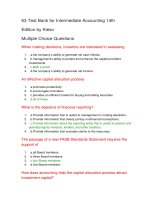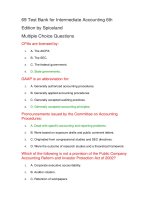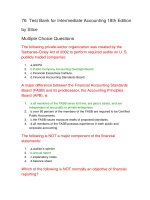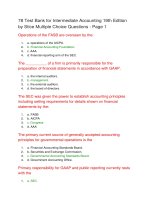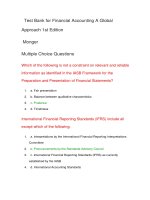87 test bank for intermediate accounting reporting and analysis 1st edition
Bạn đang xem bản rút gọn của tài liệu. Xem và tải ngay bản đầy đủ của tài liệu tại đây (126.91 KB, 28 trang )
87 Test Bank for Intermediate Accounting Reporting and
Analysis 1st Edition
True-False Questions
The convergence project between the IASB and GAAP was initiated in 2002
when the two boards entered into the “Northward Agreement”.
1.
True
2.
False
The codification was established to assist in reducing the time necessary to
research an accounting issue and improve the ability to utilize accounting
information to conform to GAAP.
1.
True
2.
False
FASB came to being in 1973 after the AICPA phased out the Accounting
Principles Board.
1.
True
2.
False
FASB’s Emerging Issues Task Force was established to identify issues in
which it felt FASB needed to address.
1.
True
2.
False
The mission of the Securities and Exchange Commission is to protect
investors, maintain orderly, and efficient markets, and assist in the formation
of capital.
1.
True
2.
False
The codification is set up as a system of levels starting with sections, topics,
and subtopics.
1.
True
2.
False
The SEC uses its authority to establish accounting standards, while also
enforcing regulations on companies, exchanges, and investors.
1.
True
2.
False
“In carrying out their responsibilities as professionals, members should
exercise sensitive professional and moral judgments in all their activities.”
This is the Integrity principle of the AICPA Code of Professional Conduct.
1.
True
2.
False
“Members should act in a way that will service the public interest, honor the
public trust, and demonstrate commitment to professionalism.” This is the
Public Interest Principle of the AICPA’s Code of Professional Conduct.
1.
True
2.
False
The balance sheet is a snapshot of a company’s financial position at a
particular date and time.
1.
True
2.
False
The need for relevant and reliable financial information stems from the needs
of the internal and external stakeholder’s.
1.
True
2.
False
A problem arising from equal information is called information asymmetry.
1.
True
2.
False
The statement of shareholder’s equity reports the effects of Accumulated
Other Comprehensive income.
1.
True
2.
False
A potential issue facing the convergence project is that many companies have
entered into contracts based upon U.S. GAAP financial reporting, many of
these contracts will have to be renegotiated using IFRS which potentially
could cause some companies more harm than good.
1.
True
2.
False
Multiple Choice Questions-Page 1
After formulating a strategic plan what three types of activities will a company
engage in?
1.
Planning, operating, and selling
2.
Investing, operating, and selling
3.
Financing, investing, and operating
4.
Operating, planning, and financing
Which of the following pronouncements issued by the FASB provides the
lowest level of authoritative support?
1.
technical bulletins
2.
interpretations
3.
statements of financial accounting standards
4.
staff positions
Going from 1938 to the present, which is the correct sequence of accounting
rule-making bodies?
1.
APB-CAP-FASB
2.
CAP-FASB-APB
3.
CAP-APB-FASB
4.
FASB-APB-CAP
Which of the following is an internal stakeholder of a company's financial
information?
1.
company treasurer
2.
stockholder in the company
3.
bank lending to the company
4.
union
What type of FASB Pronouncement carried the highest authority within GAAP,
establishing the methods and procedures required on specific accounting
issues?
1.
Staff Positions
2.
Statements of Financial Accounting Standards
3.
Statements of Financial Accounting Concepts
4.
Technical Bulletins
Concerning FASB membership, which statement is not true?
1.
Not all members are CPAs from public practice.
2.
All members are full time and fully paid.
3.
All members are also members of the Financial Accounting Foundation.
4.
All members must sever organizational ties with their previous employer.
What is Financial Reporting?
1.
The process of communicating internal accounting information to existing and potential
investors, creditors, lenders, and other external decision makers.
2.
The process of communicating financial accounting information to existing and
potential investors, creditors, lenders, and other external decision makers.
3.
The process of preparing financial accounting information to existing and potential
investors, managers, and employees.
4.
The process of communicating the strategic plan to existing and potential investors,
creditors, lenders, and other external decision makers.
While formally the SEC is charged with the responsibility for establishing
accounting principles to be followed in the preparation of SEC filings, the
impact of the SEC generally has been
1.
in its assistance to Congress with the development of tax law
2.
in guiding the development of stock exchanges
3.
ineffective in controlling foreign corporations and investors
4.
its informal review and approval of standards developed in the private sector prior to
their release
Information asymmetry problems arise because management’s behavior
1.
may be to enhance the owners' financial interests at the expense of their self-interests
2.
will always follow classic agency law
3.
may not always be in the best interests of the owners (stockholders)
4.
as agents will always be in the best interests of the owners (stockholders)
Which of the following statements is true? In order to remain impartial, the
FASB discourages public input during development of standards.
1.
FASB accounting standards are the result of clearly defined objectives, an integrated
body of theory, and the known consequences of actions.
2.
The FASB deliberates and issues accounting standards only after receiving a formal
letter of request from the SEC.
3.
Accounting standards, which reflect social decisions, are often the result of
compromise.
The organization that has legal authority to prescribe accounting principles
and reporting practices for all corporations issuing publicly traded securities
within the U.S. capital markets is?
1.
Accounting Principles Board
2.
Securities and Exchange Commission
3.
Financial Accounting Standards Board
4.
Committee on Accounting Procedure
Which pronouncements are not issued by the FASB?
1.
Statements of Financial Accounting Concepts
2.
Technical Bulletins
3.
Opinions
4.
Interpretations
The FASB Accounting Standards Codification is expected to provide all of the
following benefits except
1.
reduce the research time necessary to solve an accounting research issue
2.
codify authoritative support such as results of academic research
3.
provide real-time updates as new standards are issued
4.
improve the usability of the authoritative accounting literature
Three major organizations in the private and public sector develop U.S. and
international GAAP. They include all of the following except the
1.
EU (European Union)
2.
SEC (Securities and Exchange Commission)
3.
FASB (Financial Accounting Standards Board)
4.
IASB (International Accounting Standards Board)
What type of FASB Pronouncement were to provide more timely and
consistent application guidance and made to narrow and limit revisions of
standards?
1.
Technical Bulletins
2.
Statements of Financial Accounting Standards
3.
Interpretations
4.
None of these choices
The Financial Accounting Foundation (FAF) is the parent organization of the
which?
1.
AICPA (American Institute of Certified Public Accountants)
2.
AAA (American Accounting Association)
3.
SIFMA (Securities Industry and Financial Markets Association)
4.
FASB (Financial Accounting Standards Board)
The Securities and Exchange Commission has the legal authority to prescribe
accounting principles and reporting practices for
1.
all companies issuing publicly traded securities
2.
all companies issuing any type of securities
3.
all companies
4.
all corporations
Which of the following is not a decision that external stakeholder’s of a
company's financial information would make?
1.
whether or not to extend credit to the company
2.
whether or not to hold the company's stock
3.
whether or not the company should add a new product line
4.
whether or not to ask for an increase in employees' benefits during union contract
negotiations
How many FASB members are there?
1.
5
2.
7
3.
21
4.
33
Which of the following is NOT a major standard-setting body responsible for
the establishment of U.S. and international GAAP Generally Accepted
Accounting Principles)?
1.
SEC (Securities Exchange Commission)
2.
PCAOB (Public Company Accounting Oversight Board)
3.
FASB (Financial Accounting Standards Board)
4.
IASB (International Accounting Standards Board)
The FASB Emerging Issues Task Force issues which of the following?
1.
Statements of Position to influence the development of principles
2.
Consensus Positions on the implementation of standards
3.
Financial Reporting Releases on guidelines for reporting issues
4.
Technical Bulletins on accounting and reporting problems
Creditors' information needs revolve around all of the following decisions,
except
1.
extending credit
2.
maintaining a credit relationship
3.
not extending credit
4.
investing in credit instruments
When making decisions, equity investors are interested in assessing
1.
the company's ability to generate cash flows.
2.
management's ability to increase the capital providers' investments.
3.
the company's ability to pay dividends.
4.
All of these choices
The Securities Exchange Act of 1934 established extensive reporting
requirements for listed companies. Which is not a commonly required report?
1.
Form 10-Q. An extensive quarterly report, including financial statements.
2.
Form S-2. A registration statement
3.
Form 10-K. An extensive annual report, including financial statements
4.
Form 8-K. A report used to describe significant events that may affect the company.
The primary reason that financial accounting and managerial accounting have
somewhat different objectives is because they
1.
need information in different formats
2.
provide information for different decisions
3.
need information in different geographic locations
4.
need information at different times
What type of FASB pronouncements refined GAAP by clarifying conflicting or
unclear issues relating to previously issued standards?
1.
Staff Positions
2.
Technical Bulletins
3.
Interpretations
4.
Other Pronouncements
As a potential equity investor, what would you least be interested in a
company prior to making and investment decision?
1.
What differentiates them from their competition?
2.
Whether they are generating a profit?
3.
Whether they have positive cash flows?
4.
What are the employee benefits and compensation packages?
Which of the following statements is true?
1.
Accounting standard setting began in the United States when the AICPA formed the
Committee on Accounting Procedure.
2.
Accounting standard setting began in the United States when the SEC formed the
Committee on Accounting Procedure.
3.
Accounting standard setting began in the United States when the AICPA formed the
Accounting Principles Board.
4.
Accounting standard setting began in the United States when the FASB formed the
Committee on Accounting Procedure.
Which organization has the most legal authority?
1.
Financial Accounting Standards Board
2.
Accounting Standards Executive Committee
3.
Governmental Accounting Standards Board
4.
Securities and Exchange Commission
What is the relationship between the Securities and Exchange Commission
and accounting standard setting in the United States?
1.
The SEC requires all companies listed on an exchange to submit their financial
statements to the SEC.
2.
The SEC coordinates with the FASB in establishing accounting standards.
3.
The SEC has a mandate to establish accounting standards for corporations within the
U.S. capital markets.
4.
The SEC reviews financial statements for compliance with U.S. GAAP or IFRS.
59 Free Test Bank for Intermediate Accounting Reporting
and Analysis 1st Edition by Wahlen Multiple Choice
Questions-Page 2
Which of the following is not considered an ethical issue in accounting?
1.
Biased financial statement presentation
2.
Accelerated revenue recognition
3.
Earnings manipulation
4.
Industry practices
Notes to financial statements provide
1.
discussions that further explain items shown in the financial statements
2.
comparative financial information with the previous year
3.
management's discussions about plans for the future
4.
the report of the independent auditors
Contributions that are paid to owners would affect both the
1.
balance sheet and statement of cash flows
2.
balance sheet and income statement
3.
income statement and statement of changes in equity
4.
income statement and statement of cash flows
The four major financial statements of a corporation consist of the
1.
income statement, balance sheet, statement of cash flows, and statement of changes
in stockholders' equity
2.
balance sheet, statement of cash flows, statement of retained earnings, and income
statement
3.
income statement, statement of cash flows, statement of financial flexibility, and
balance sheet
4.
statement of cash flows, balance sheet, income statement, and statement of capital
equity
Which of the following is NOT a major standard-setting body responsible for
the establishment of U.S. and international GAAP (Generally Accepted
Accounting Principles)?
1.
SEC (Securities Exchange Commission)
2.
PCAOB (Public Company Accounting Oversight Board)
3.
FASB (Financial Accounting Standards Board)
4.
IASB (International Accounting Standards Board)
Auditors face ethical issues because
1.
GAAP permits various standards to be used to produce profits
2.
auditors may express an opinion that may cause difficulty to employees of a company
3.
auditors may not discover insider trading
4.
GAAP does not permit fraud
U.S. companies that have subsidiaries in foreign countries can file their
financial statements with the SEC by using?
1.
IFRS
2.
GAAP
3.
either IFRS or GAAP
4.
IFRS for their subsidiaries and GAAP for their holdings in the United States.
The agreement in 2002 by the FASB and IASB to develop high quality,
compatible accounting standards that could be used by both domestic and
cross-border financial reporting was called the
1.
International Accounting Standards agreement
2.
Financial Accounting Standards Board Global agreement
3.
Norwalk agreement
4.
United GAAP agreement
Which statement measures and reports the financial results of a company’s
performance for a period of time?
1.
income statement
2.
balance sheet
3.
statement of cash flows
4.
statement of financial position
The stated principles of the AICPA Code of Professional Conduct do NOT
include
1.
Integrity
2.
Honesty
3.
Objectivity and Independence
4.
Responsibilities
What is the name of the parent organization to the International Accounting
Standards Board?
1.
IASB (International Accounting Standards Board)
2.
IFRS (International Financial Reporting Standards)
3.
FASB (Financial Accounting Standards Board)
4.
IFRIC (International Financial Reporting Standards Interpretations Committee)
The FASB Accounting Standards Codification includes six levels or
components which of these is not a level?
1.
Area
2.
Topic
3.
Sub-paragraphs
4.
Paragraphs
Unethical actions include which of the following?
1.
polluting lakes and streams
2.
overcharging on government contracts
3.
securities fraud
4.
All of these choices
Which Principle of the AICPA Code of Professional Conduct is: Members
should perform all of their professional responsibilities with the highest sense
of integrity possible. This ensures trust and public confidence in the
profession?
1.
Scope and Nature of Services
2.
Due Care
3.
Integrity
4.
Objectivity and Independence
The Management Discussion and Analysis section of the financial statements
discusses what important topics?
1.
Business risk factors associated with the company.
2.
Management provides insight into key decisions implemented during that time period
and future developments.
3.
Management utilizes this area as a forum to discuss strategic motives.
4.
All of these choices
Which of the following transactions would be reported in the cash flows from
investing activities section in the statement of cash flows for the Harlem
Company?
1.
Harlem sold a piece of land for $600,000.
2.
Harlem borrowed $3,000,000
3.
Harlem issued common stock for $700,000 to investors.
4.
Harlem paid a cash dividend to its stockholders.
Which of the following documents includes all of the accounting standards?
1.
Regulation S-X
2.
The FASB Conceptual Framework
3.
Statements of Financial Accounting Standards
4.
none of these
The correct presentation of the income statement is?
1.
Revenues - expenses + gains - losses = Net Income
2.
Revenues-expenses = Net income - losses + gains
3.
Revenues- losses - expenses + gains = Net Income
4.
Revenues + gains - losses -expenses = Net Income
Conversion to IFRS reporting by all U.S. companies would be best
accomplished with a transition plan for all of the following reasons except
1.
it would have to be a multi-year process
2.
it needs to be an orderly process with a minimum of cost and disruption to the
participants
3.
certain IFRS need further improvement through continued convergence efforts
4.
careful planning would enable maximum manipulation of the IFRS for the financial
benefit of the United States.
Which Principle of the AICPA Code of Professional Conduct is: A member
should be free from conflicts of interest and be objective. A member should
be free of bias and provide auditing and attestation services in an
independent manner?
1.
Objectivity and Independence
2.
Integrity
3.
Responsibilities
4.
Due Care
The correct order of presentation for the statement of cash flows is?
1.
Operating, Investing, Financing
2.
Financing, Operating, Investing
3.
Investing, Financing, Operating
4.
Operating, Financing, Investing
What is the responsibility of the International Accounting Standards Board?
1.
IASB promotes uniform accounting standards among international countries.
2.
IASB settles accounting disputes between auditors and international companies.
3.
IASB issues standards which regulate the financial accounting and reporting of
multinational
4.
corporations and then enforces through legal channels.
5.
IASB is to develop a uniform currency in which the financial transactions would be
measured.
Certain U.S. accounting standards have been, and will be, amended to aid in
the international convergence process. The process of changing these
standards usually involves
1.
a short deliberation followed by a vote of the U.S. Congress
2.
acceptance of the change by the Internal Revenue Service
3.
rejecting all existing standards and developing an entirely new concept
4.
selecting the best standard between existing U.S. and international standards
For foreign companies that issue securities in the United States to raise
capital, the SEC
1.
requires these companies to file form 20-F which reconciles certain amounts reported
in their financial statements with US GAAP.
2.
accepts all financial statements that use IFRS.
3.
accepts only financial statements that are fully stated under US GAAP.
4.
accepts financial statements from foreign companies that use English-language IFRS
without exception.
Which Principle of the AICPA Code of Professional Conduct is: As a member
one should continually strive to improve competence, observe all ethical
standards and provide services to the best of their ability?
1.
The Public Interest
2.
Responsibilities
3.
Scope and Nature of Services
4.
Due Care
The accounting equations is
1.
Assets + Liabilities = Stockholder's Equity
2.
Assets -Liabilities = Stockholder’s Equity
3.
Assets = Liabilities - Stockholder’s Equity
4.
Assets + Stockholders' Equity = Liabilities
The AICPA Code of Professional Conduct includes which of the following
principles?
1.
Professionalism
2.
Conservatism
3.
Objectivity
4.
Quality
Assume that authoritative support regarding GAAP for a particular transaction
is needed. A correct hierarchy of authority to be followed (highest, second,
third) would be
1.
FASB Statements, AICPA Accounting Interpretations, FASB Technical Bulletins
2.
FASB Technical Bulletins, AICPA Accounting Interpretations, FASB Statements
3.
AICPA Accounting Interpretations, FASB Technical Bulletins, FASB Statements
4.
FASB Statements, FASB Technical Bulletins, AICPA Accounting Interpretations
What financial statement is considered the cornerstone of financial
reporting?
1.
income statement
2.
statement of cash flows
3.
statement of retained earnings
4.
balance sheet
Free Text Questions
The demand for accounting information arises from the informational needs
of various stakeholders. Required: List five internal stakeholders or external
stakeholders.
Answer Given
Internal: Employees; Executives. External: Customers; Suppliers; Banks; Creditors;
Equity investors; Communities; Tax Authorities; Government; Pension Funds; Labor
Unions.
What are the FASB operating procedures when reviewing whether to issue a
new standard?
Answer Given
1) Identify a topic 2) Appoint a task force 3) Conduct research 4) Issue Preliminary
views or invitations to comment 5) Hold public hearings 6) Deliberate on findings 7)
Issue exposure draft 8) Hold public hearings 9) Modify the exposure draft 10) Vote 11)
Issue an Accounting Standard update
What is the responsibility of FASB?
Answer Given
FASB is responsible for identifying financial issues, conducting the necessary research
to address the issues, and provide a resolution to the issue by issuing a new
accounting standard.
What is the mission of the Securities and Exchange Commission? How did
the SEC come into being?
Answer Given
The mission of the SEC is to “protect investors, maintain fair, orderly, and efficient
markets, and facilitate capital formation.” The SEC was created by the Securities Act
of 1933 and the Securities Exchange Act of 1934. The SEC has the legal authority
over the accounting principles and reporting practices for all corporations that issue
public securities within the U.S. capital markets.
The FASB and IASB have some ambitious accounting standards projects to
complete prior to their convergence. List five of the projects currently on the
agenda.
Answer Given
1) consolidated financial statements 2) fair value measurement 3) financial statement
presentation 4) leases 5) financial instruments 6) revenue recognition
The FASB Codification consists of six components or levels, what are the
components or levels?
Answer Given
1) Areas 2) Topics 3) Subtopics 4) Sections 5) Subsections 6) Paragraphs
Define: 1) What are assets? 2) What are liabilities? 3) What is shareholder’s
equity? 4) What financial statement would one find assets, liabilities and
shareholder’s equity?
Answer Given
1) Assets are resources the firm owns that will provide a future economic benefit to the
company. 2) Liabilities are claims to the resources owned by the firm. These items are
obligations owed by the company. 3) Shareholder’s equity is the residual claim to the
resources of the firm. In the event of liquidation this would be whatever is left after the
sale of the assets and payment of the liabilities. 4) Balance Sheet
What are the six areas covered in the AICPA Code of Professional Conduct?
Answer Given
1) Responsibilities 2) The Public Interest 3) Integrity 4) Objectivity and Independence
5) Due Care 6) Scope and Nature of Services
Your accounting instructor allows you to look at his grade book in order to
verify the points you have received to date in the final course taken by all
accounting majors. While looking at your points, you notice that your best
friend's score on the last exam was recorded incorrectly. He received a 68 on
the test but it has been recorded as an 86 in the grade book. Your friend
needs a passing grade in this class in order to graduate. If the correct score is
recorded, he might not have enough points to pass
Answer Given
Students may in a variety of ways, however, their answers should include the following
steps: (1) identifying the stakeholders (the student, the friend, and the instructor) and
the student's responsibilities (to him/herself, the friend, and the instructor); (2)
discussion of the three ethical criteria, (a) utility: what action would be optimal for all
stakeholders?, (b) rights: what action respects the rights of all the stakeholders?, (c)
justice: what action is fair and just?; (3) identifying any "overwhelming factors" that
might justify disregarding one or more of the three ethical criteria; and (4) deciding if
the action to be taken is ethical.
Prior to 2009, the FASB issued several types of pronouncements which had
differing levels of authority. Explain the differing types of pronouncements,
provide a brief explanation as to what changed after 2009 and why is it still
important today?
Answer Given
FASB Pronouncements were issued with differing levels of authority. Statements of
Financial Accounting Standards had the most authority in regards to specific topics.
These pronouncements established the methods and procedures required for specific
accounting issues. Interpretations had the next level of authority. The Interpretations
provided clarification on unclear or conflicting issues as they related to issued
standards. Staff Positions provided more application guidance allowing for limited or
narrow revisions of already established standards. After Staff Positions followed
Technical bulletins. These were issued due to reporting problems as they related to
specific standards. The bulletins provided additional information to clarify, explain, or



